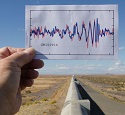Quantum tractor beam could tug atoms, molecules
will.ferguson
The wavelike properties of quantum matter could lead to a scaled-down version of Star Trek technology. A new kind of tractor beam could use a beam of particles to reel in atoms or molecules, physicists propose in the May 5 Physical Review Letters.
“The idea is very reasonable,” says Philip Marston of Washington State University in Pullman. Although the results are still theoretical, “I think somebody will probably find some way to demonstrate this in the lab,” Marston says.



